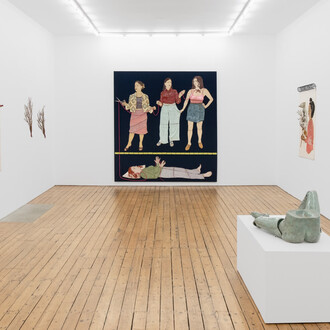In her new exhibition, The American Colony, Oppenheim highlights her unique ability to translate historical subjects and early methods of photo-making through contemporary experimental darkroom processes. In these new works, the artist explores stereoscopy in particular, a technique popular in the late 19th and early 20th centuries for its pseudo-3D effect in which two images of the same object are taken from slightly different angles and then are optically merged through a viewing device.,. In Wildflowers of Palestine and Religious Paintings, she exposes both sides of a stereoscopic negative on a single piece of paper creating a new double image not visible in the original stereographic views.
In Wall to stop Locusts, Oppenheim reframes a series of stereoscopic images of a zinc wall commissioned by Ottoman authorities in the Judean desert in 1915 to prevent swarms of locusts from descending into the farmland surrounding Jerusalem as well as the city itself. In these images, the line between stereoscopic halves as well as damage that time has wrought on the original negatives become structural elements in the composition, creating a visual barrier between images. Through this reframing, Oppenheim draws a subtle relationship between contemporary politics and these images from a little remembered but devastating plague of locusts.
The source material derives from the enormous image archive of the American Colony in Jerusalem, now housed in the Library of Congress Collection. The American Colony began as a Christian utopian society that settled in Jerusalem in the mid 19th in order to engage in philanthropic activities and exists today as an international hotel frequented by journalists, diplomats and UN officials alike due to its historical neutral status outside of the turbulent politics of the land.
















